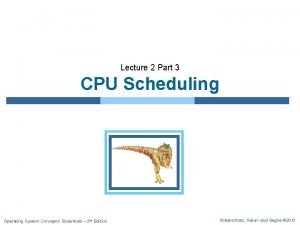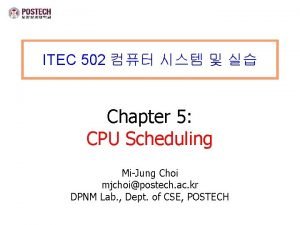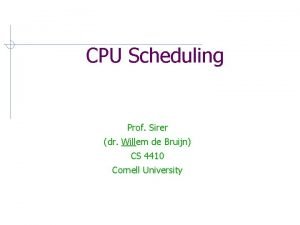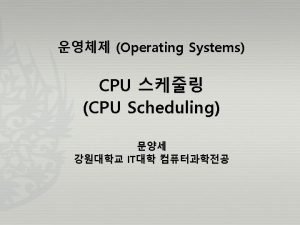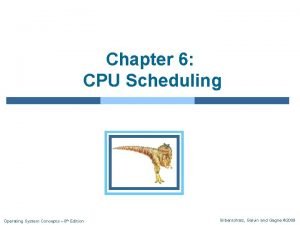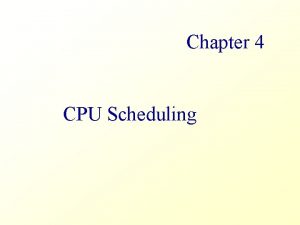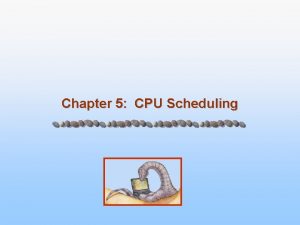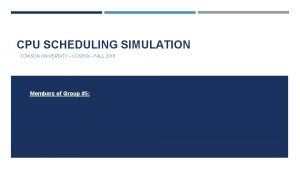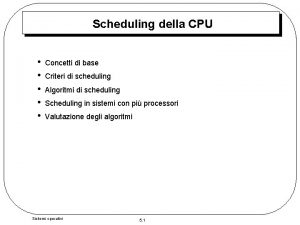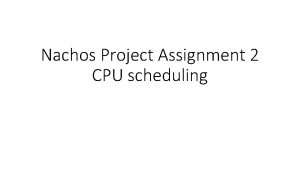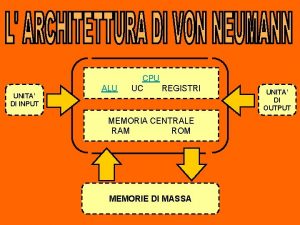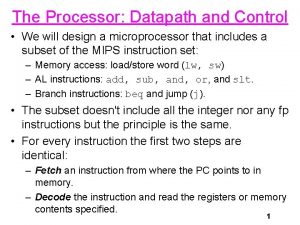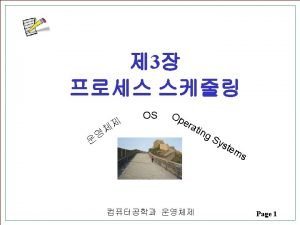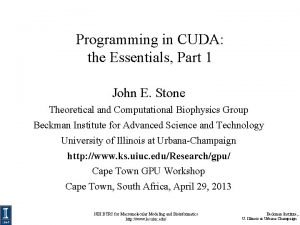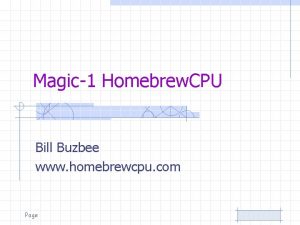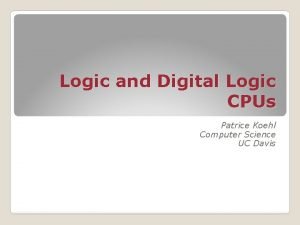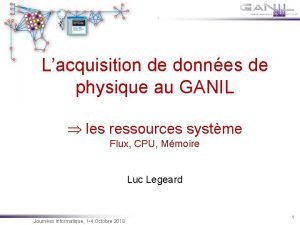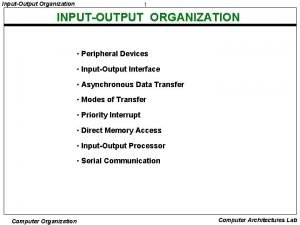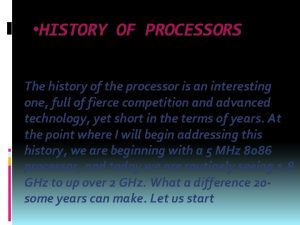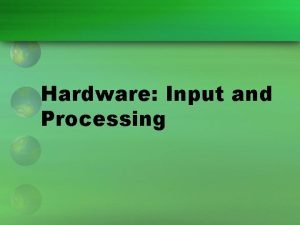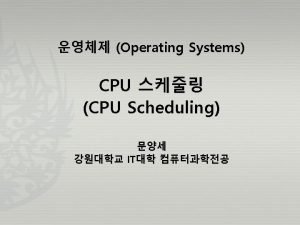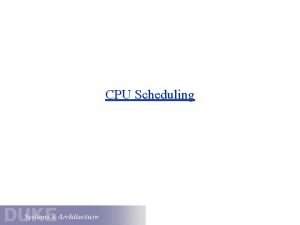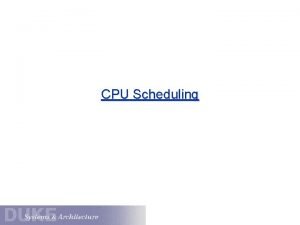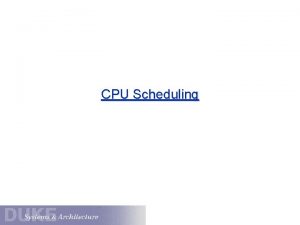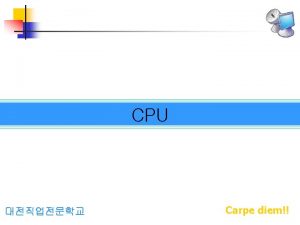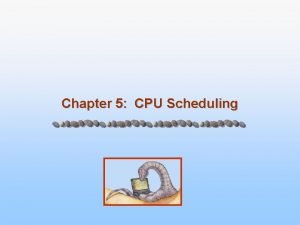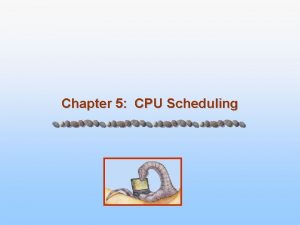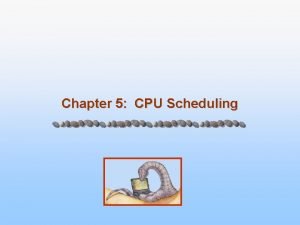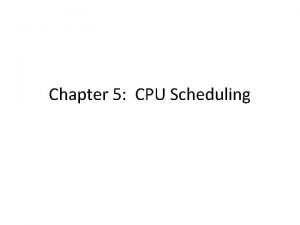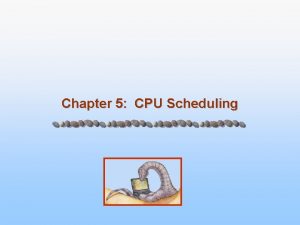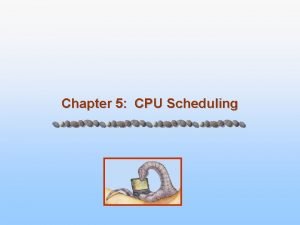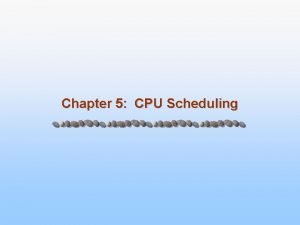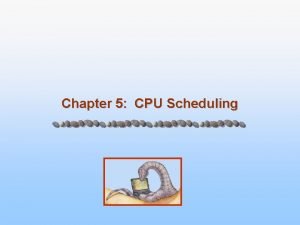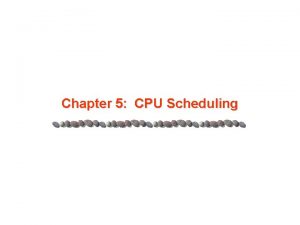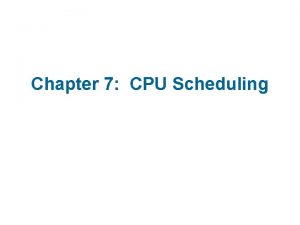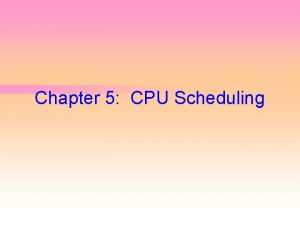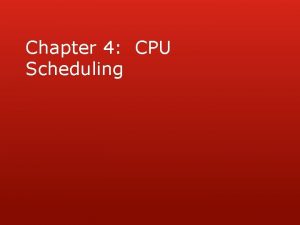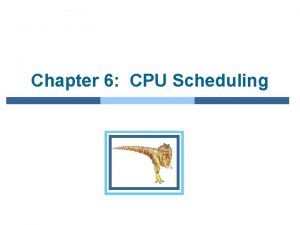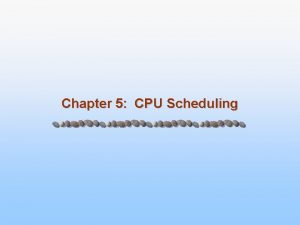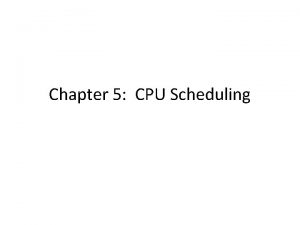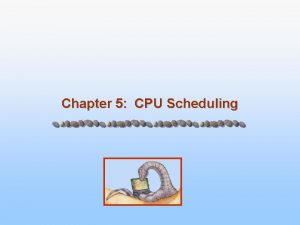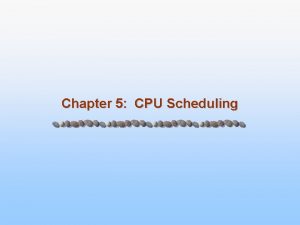Chapter 5 CPU Scheduling Chapter 5 CPU Scheduling





























- Slides: 29

Chapter 5: CPU Scheduling

Chapter 5: CPU Scheduling Basic Concepts Scheduling Criteria Scheduling Algorithms Multiple-Processor Scheduling Real-Time Scheduling Thread Scheduling Operating Systems Examples Java Thread Scheduling Algorithm Evaluation

Basic Concepts Maximum CPU utilization obtained with multiprogramming CPU–I/O Burst Cycle – Process execution consists of a cycle of CPU execution and I/O wait CPU burst distribution

Alternating Sequence of CPU And I/O Bursts

Histogram of CPU-burst Times

CPU Scheduler Selects from among the processes in memory that are ready to execute, and allocates the CPU to one of them CPU scheduling decisions may take place when a process: 1. Switches from running to waiting state (e. g. IO request) 2. Switches from running to ready state (e. g. interrupt) 3. Switches from waiting to ready (e. g. IO complete) 4. Terminates Scheduling under 1 and 4 is nonpreemptive All other scheduling is preemptive

Dispatcher module gives control of the CPU to the process selected by the short-term scheduler; this involves: switching context switching to user mode jumping to the proper location in the user program to restart that program Dispatch latency – time it takes for the dispatcher to stop one process and start another running

Scheduling Criteria CPU utilization – keep the CPU as busy as possible Throughput – # of processes that complete their execution per time unit Turnaround time – amount of time to execute a particular process Waiting time – amount of time a process has been waiting in the ready queue Response time – amount of time it takes from when a request was submitted until the first response is produced, not output (for time-sharing environment)

Optimization Criteria Max CPU utilization Max throughput Min turnaround time Min waiting time Min response time

First-Come, First-Served (FCFS) Scheduling Process Burst Time P 1 24 P 2 3 P 3 3 Suppose that the processes arrive in the order: P 1 , P 2 , P 3 The Gantt Chart for the schedule is: P 1 0 24 Waiting time for P 1 = 0; P 2 = 24; P 3 = 27 Average waiting time: (0 + 24 + 27)/3 = 17 P 2 P 3 27 30

FCFS Scheduling (Cont. ) Suppose that the processes arrive in the order P 2 , P 3 , P 1 The Gantt chart. Pfor the schedule is: P 2 0 3 3 6 Waiting time for P 1 = 6; P 2 = 0; P 3 = 3 Average waiting time: (6 + 0 + 3)/3 = 3 Much better than previous case Convoy effect short process behind long process P 1 30

Shortest-Job-First (SJF) Scheduling Associate with each process the length of its next CPU burst. Use these lengths to schedule the process with the shortest time Two schemes: nonpreemptive – once CPU given to the process it cannot be preempted until completes its CPU burst preemptive – if a new process arrives with CPU burst length less than remaining time of current executing process, preempt. This scheme is know as the Shortest-Remaining-Time-First (SRTF) SJF is optimal – gives minimum average waiting time for a given set of processes

Example of Non-Preemptive SJF Process Arrival Time P 1 0. 0 P 2 2. 0 P 3 4. 0 P 4 5. 0 SJF (non-preemptive) P 1 P 3 0 3 7 Burst Time 7 4 1 4 P 2 8 Average waiting time = (0 + 6 + 3 + 7)/4 = 4 P 4 12 16

Example of Preemptive SJF Process P 1 P 2 P 3 P 4 SJF (preemptive) P 1 P 2 0 2 Arrival Time 0. 0 2. 0 4. 0 5. 0 P 3 4 P 2 5 Burst Time 7 4 1 4 P 4 7 Average waiting time = (9 + 1 + 0 +2)/4 = 3 P 1 11 16

Determining Length of Next CPU Burst Can only estimate the length Can be done by using the length of previous CPU bursts, using exponential averaging formula Tn+1=αtn+ (1 -α)Tn tn contain resent history Tn stores past history αControls the relative weight of resent and past history If α = 0 then history has no effect

Examples of Exponential Averaging =0 n+1 = n Recent history does not count =1 n+1 = tn Only the actual last CPU burst counts If we expand the formula, we get: n+1 = tn+(1 - ) tn -1 + … +(1 - )j tn -j + … +(1 - )n +1 0 Since both and (1 - ) are less than or equal to 1, each successive term has less weight than its predecessor

Priority Scheduling A priority number (integer) is associated with each process The CPU is allocated to the process with the highest priority (smallest integer highest priority) Preemptive nonpreemptive SJF is a priority scheduling where priority is the predicted next CPU burst time Problem Starvation – low priority processes may never execute Solution Aging – as time progresses increase the priority of the process

Round Robin (RR) Each process gets a small unit of CPU time (time quantum), usually 10 -100 milliseconds. After this time has elapsed, the process is preempted and added to the end of the ready queue. If there are n processes in the ready queue and the time quantum is q, then each process gets 1/n of the CPU time in chunks of at most q time units at once. No process waits more than (n-1)q time units. Performance q large FIFO q small q must be large with respect to context switch, otherwise overhead is too high

Example of RR with Time Quantum = 20 Process P 1 P 2 P 3 P 4 The Gantt chart is: P 1 P 2 P 3 Burst Time 53 17 68 24 P 1 P 3 P 4 P 1 P 3 0 20 37 57 77 97 117 121 134 154 162 Typically, higher average turnaround than SJF, but better response

Time Quantum and Context Switch Time

Turnaround Time Varies With The Time Quantum

Multilevel Queue Ready queue is partitioned into separate queues: foreground (interactive) background (batch) Each queue has its own scheduling algorithm foreground – RR background – FCFS Scheduling must be done between the queues Fixed priority scheduling; (i. e. , serve all from foreground then from background). Possibility of starvation. Time slice – each queue gets a certain amount of CPU time which it can schedule amongst its processes; i. e. , 80% to foreground in RR 20% to background in FCFS

Multilevel Queue Scheduling

Multilevel Feedback Queue A process can move between the various queues; aging can be implemented this way Multilevel-feedback-queue scheduler defined by the following parameters: number of queues scheduling algorithms for each queue method used to determine when to upgrade a process method used to determine when to demote a process method used to determine which queue a process will enter when that process needs service

Example of Multilevel Feedback Queue Three queues: Q 0 – RR with time quantum 8 milliseconds Q 1 – RR time quantum 16 milliseconds Q 2 – FCFS Scheduling A new job enters queue Q 0 which is served FCFS. When it gains CPU, job receives 8 milliseconds. If it does not finish in 8 milliseconds, job is moved to queue Q 1. At Q 1 job is again served FCFS and receives 16 additional milliseconds. If it still does not complete, it is preempted and moved to queue Q 2.

Multilevel Feedback Queues

Multiple-Processor Scheduling CPU scheduling more complex when multiple CPUs are available Homogeneous(Identical) processors within a multiprocessor Load sharing Push Migration- A specific task keeps on checking and it pushes a process to a less busy processor if other processor is loaded more. Pull Migration- In this a processor by itself pull a process from a busy processor when it gets idle.

Approaches to Multi-processor Scheduling Asymmetric multiprocessing – only one processor accesses the system data structures and system activities and scheduling. Minimizing the need for data sharing and it is simple. The other Processors execute user work. Symmetric multiprocessing – In this approach each processor is self scheduling. All processes may have its own ready queue or separate queue. Scheduler for each queue will select the process from the queue.

Real-Time Scheduling Hard real-time systems – required to complete a critical task within a guaranteed amount of time Soft real-time computing – requires that critical processes receive priority over less fortunate ones
 Sjf cpu scheduling
Sjf cpu scheduling Cpu scheduling gantt chart
Cpu scheduling gantt chart Sjf cpu scheduling
Sjf cpu scheduling First come first serve calculator
First come first serve calculator Sjf cpu scheduling
Sjf cpu scheduling Sjf cpu scheduling
Sjf cpu scheduling Waiting time in cpu scheduling
Waiting time in cpu scheduling A cpu scheduling algorithm determines an order
A cpu scheduling algorithm determines an order Cpu scheduling project
Cpu scheduling project Scheduling della cpu
Scheduling della cpu Cpu scheduling project
Cpu scheduling project Sjn scheduling
Sjn scheduling Alu uc
Alu uc Cpu datapath
Cpu datapath Rr 스케줄링
Rr 스케줄링 Partes internas y externas del computador
Partes internas y externas del computador Rom cpu
Rom cpu John cuda
John cuda El case y sus partes
El case y sus partes In this scheme cpu execution waits while i/o proceeds.
In this scheme cpu execution waits while i/o proceeds. Function of a microprocessor
Function of a microprocessor Bill buzbee
Bill buzbee Cpu consists of
Cpu consists of Cpu
Cpu Cpu input or output
Cpu input or output Initializing cgroup subsys cpu
Initializing cgroup subsys cpu Maqueta de las partes internas del cpu
Maqueta de las partes internas del cpu The history of cpu
The history of cpu Hertz cpu
Hertz cpu Cpu consists of
Cpu consists of
